The effect of Mycoplasma gallisepticum (MG) and Mycoplasma synoviae (MS) on mother flock and in hatcheries

Dr. Majed Hamid Al-Saegh / Australia
29/6/2024
Introduction
Mycoplasma is one of the most important diseases in poultry production, especially with regard to its economic impact. This highlights the importance of controlling the rate of vertical transmission of Mycoplasma gallisepticum (MG) and Mycoplasma synovii (MS). To achieve this control of vertical transmission, it is necessary to focus on maternal mycoplasma control strategies.
First: the effect of MG and MS on the mother stock
MG (Mycoplasma gallisepticum):
Infection in mothers: MG causes clinical or subclinical infections in mothers. Affected birds show decreased feed consumption, weight loss, drop in egg production, increased feed consumption per chick, and decreased hatching rate. MG leads to respiratory infections, such as nasal discharge, and cough. The main concern remains disruption to production rather than loss of birds. After infection, the disease is transmitted vertically causing the transmission rate which decline over time but recovered birds remain carriers for lifetime.
MS (Mycoplasma synoviae):
The Infection in mothers: MS causes production disorders, especially infections of the upper respiratory tract and synovial joints. The infection leads to air sac lesions when compared with other viral diseases such as ND and IB. The infection leads to synovitis and tenosynovitis, causing lameness in male and female birds, but is more frequently observed in males. This affects mobility and the chance of getting fertilized eggs. Female birds show disturbances in production and changes in egg quality.
Effect of MG and MS on egg quality: Changes in the reproductive system caused by Mycoplasma infection directly affect egg quality, leading to a decrease in the number of marketing eggs and an increase in secondary eggs, and thus direct economic losses. MS infection has effects on egg shell quality and can increase egg surface porosity, facilitating bacterial entry and causing egg yolk infection and egg bursting in the incubator.

Second: The effect of MG and MS on hatching
Quality of hatched eggs:
The effect of infection on hatchability: The quality of hatched eggs is directly affected by mycoplasma infection, which leads to decreased hatchability and increased embryonic mortality. Bacteria such as E. coli or Pseudomonas spp. It easily enters the egg and causes the eggs to explode, resulting in egg material sticking to the uninfected hatched eggs, causing later infection and increasing early mortality of the chicks.
Fertility analysis:
Fertility screening: Egg shell strength can be checked, and eggs hatched from mother stock with MS may show greater porosity. This can be corrected when the mother birds are treated with a good antibiotic such as Tyvalosin. After treatment, an improvement in egg shell quality can be observed, which increases the hatching rate and improves the inspection process.

Diagnosis
Laboratory support:
The importance of correct diagnosis: The use of molecular diagnosis such as qPCR, or serological diagnosis such as ELISA or RPA to confirm mycoplasma infection is necessary. Another valuable diagnostic technique is the analysis of lobulated embryos (PIPs), which evaluates the effect of vertical transmission by evaluating unhatched lobulated eggs. Analysis of PIPs should be performed routinely to ensure a correct baseline.
Conclusion
Control and diagnosis of Mycoplasma MG and MS infections in mother stock and hatchlings is critical to maintaining herd health and productivity. This can be done through the use of vertical transmission control strategies and accurate diagnosis.



